“CNC milling is the combination of precise tools, digital commands, and rapid machine movements. However, it requires comprehensive skill or guidance to begin any project.”
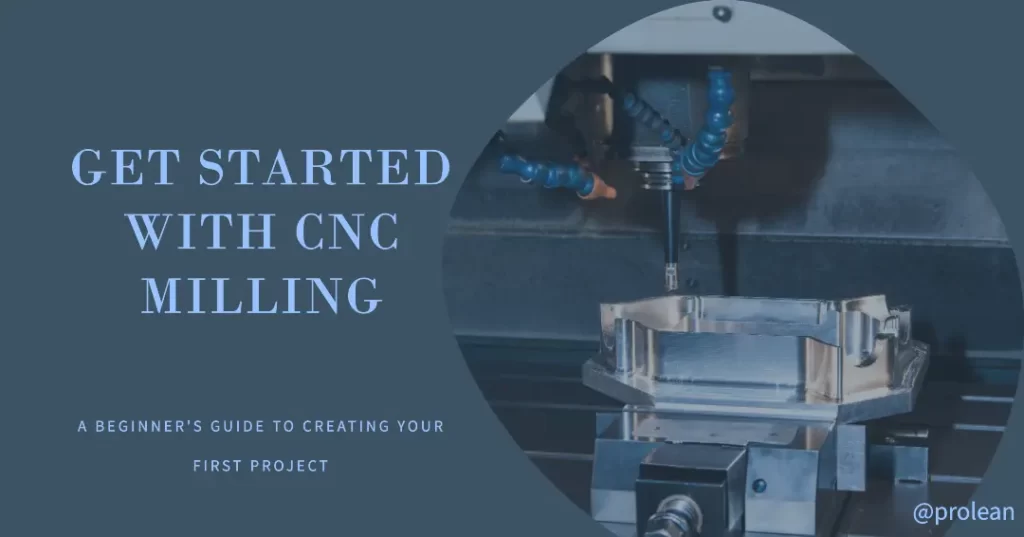
If you are stepping into the vast domain of CNC Milling, the initial stages might appear intricate and challenging. CNC technology has a significant role in the automation of the manufacturing industry. It involves using computer programs to control the movement and operation of machinery, enabling exact and consistent results. Manufacturers use different CNC milling operations to shape the workpiece based on the material type, design specifications, and complexity. Manufacturers use different CNC machining processes to shape the workpiece based on the material type, design specifications, and complexity. The standard CNC machining processes are CNC milling, CNC turning, CNC routing, and CNC drilling. However, this article will only cover the milling process, including its process, different operations, advantages, disadvantages, and milling services.
This beginner’s guide offers foundational knowledge and insights into the CNC milling process. Whether you’re an aspiring engineer, a hobbyist, a mechanic, someone looking for related services, or have curiosity.
What is CNC Milling?
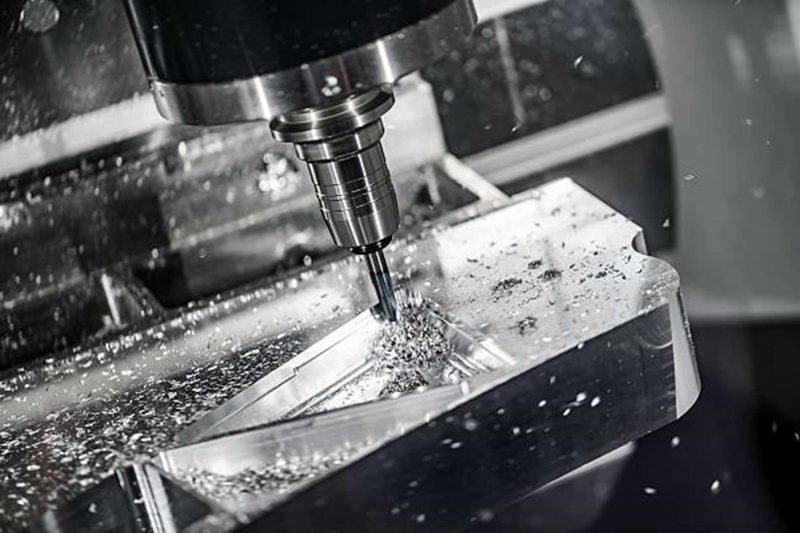
CNC milling process
CNC milling is a subtractive manufacturing approach that involves removing material to convert the workpiece into the desired shape using a CNC milling machine. The material removal process uses CNC machining cutting tools, such as end mills and drill bits, where cutting tools are controlled by a computer program that specifies the tool path and cutting parameters, such as cutting speed and depth of cut.
CNC milling machines are used in the milling process, which is highly versatile and can perform a wide range of milling operations. They are capable of cutting a variety of materials, from plastics and composites to metals and alloys. Typically, CNC milling technology can create parts with tolerances as tight as ± 0.001 inches to ±0.005 inches. However, the CNC milling machine must be highly accurate and precise to achieve these tolerances.
Difference between CNC milling and CNC turning
CNC milling and turning are two computer-controlled machining processes that differ significantly in their ability to create various shapes and features, the number of axes they operate in, and the types of workpieces they can handle. Therefore, understanding the differences is beneficial to choosing the appropriate machining process for a particular job.
Table: CNC Milling Vs Turning
| Category | CNC Milling | CNC Turning |
|---|---|---|
| Cutting tool | Rotating multi-point cutting tool | Single-point cutting tool |
| Process | Material is removed from a workpiece using rotating cutting tools guided by a computer program. | Material is removed from a rotating workpiece using a stationary cutting tool guided by a computer program. |
| Applications | Producing a wide range of parts, including complex shapes and features. | Producing cylindrical parts, such as shafts, bushings, and flanges, often for high-volume production. |
| Material | Can work with various materials, including metals, plastics, composites, etc. | Can work with various materials, including metals, plastics, composites, etc. |
| Features | Capable of producing pockets, slots, holes, threads, chamfers, and complex 3D shapes. | Capable of producing threads, grooves, chamfers, and other cylindrical features. |
| Advantages | Versatility for complex shapes and features, Precision & repeatability. , and Flexibility in material selection. | Efficiency for high-volume production, Simplicity in setup and operation, and Cost-effective for high-volume production. |
| Limitations | Cost, especially for large or high-precision machines, Setup time for tool changes and workpiece alignment, and Material waste during the milling process. | Limited to producing cylindrical shapes and features, Less versatility for complex parts, and Lower precision for complex parts with tight tolerances. |
Components & Features of CNC Milling Machines
Embarking on the journey of CNC milling inevitably leads one to recognize the machine’s intricacies. Each feature, though appearing as mere metal parts, comes together to form a symphony of precision and accuracy. Let’s take a look at the key components and their significant roles.
Table: Key Components of CNC-milling machines
| Component | Primary Role | Functionality & Importance | Maintenance & Additional Notes |
| Worktable | The foundation of the milling process | Holds workpiece and provides stability. Ensures the workpiece remains stationary for tool interaction. | Should remain in prime condition; free from obstructions or debris. |
| Saddle | A bridge between the worktable and the machine | Ensures proper alignment by supporting the worktable. Maintains balance and stability of the setup. | Vital for preventing unnecessary shifts or movements during operations. |
| Knee | Elevating or lowering the worktable | Adjusts the height of the worktable. Essential for workpieces of varying sizes and specific cut depths. | Imagined as the CNC machine’s legs, facilitating height adjustments. |
| Column | The backbone of the CNC milling machine | Provides support to the spindle, knee, and other components. Offers structural integrity. | Its robustness and rigidity play a part in ensuring a stable milling process. |
| Spindle | Controls the machine tool | and Determines the tool’s rotation and movement. Influences cut quality based on speed, alignment, and position. | Regular maintenance and calibration are crucial for optimal performance. |
| Machine Tool | Interacts with the workpiece | Physically shapes the workpiece. Varies based on the milling operation, e.g., drills, and end mills. | Each tool is tailored for a specific task, ensuring precision in milling processes. |
To appreciate these components, understanding their interaction is essential. Their coordinated movement dictates the success of the milling operation, guided by the CNC machine’s programming. For example, as the spindle controls the machine tool’s movement, the worktable, supported by the saddle and adjusted by the knee, holds the workpiece firmly. This synchronized ballet ensures the machine tool interacts flawlessly with the workpiece, all while the column ensures stability.
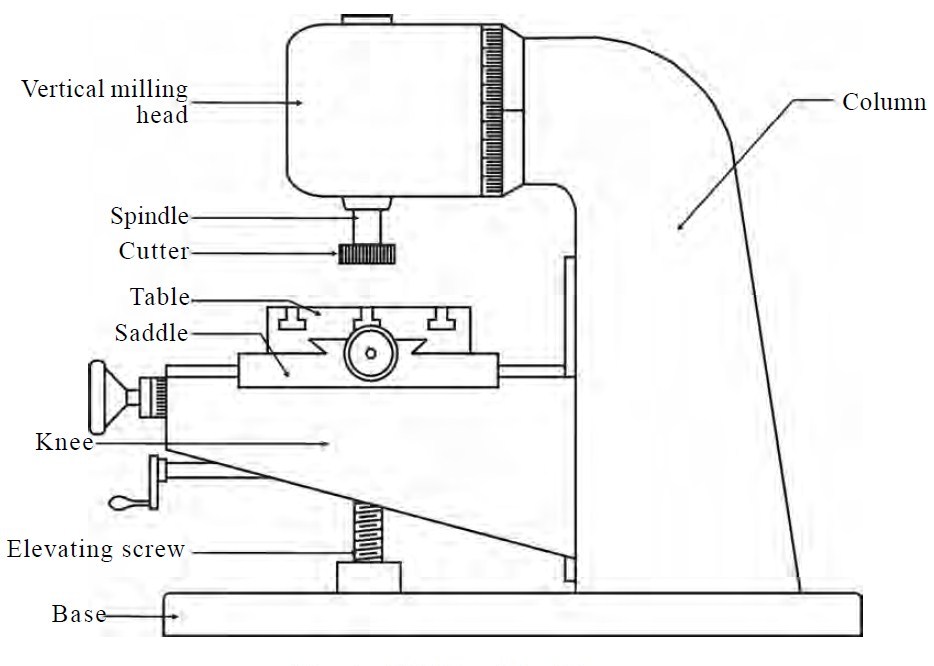
CNC milling machine components
What is the Small CNC Mills?
A small CNC mill is a type of milling machine smaller than traditional CNC mills. It makes small CNC mills more suitable for home workshops or small businesses. Furthermore, they can work with metal, plastic, and wood to create precise cuts, holes, and shapes with high accuracy.
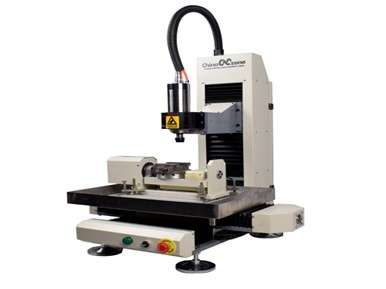
Small CNC mills
The following are some examples that can be made with a small CNC mill
- Custom parts for machinery or equipment
- Rapid Prototyping for new products
- Decorative objects, such as signs or sculptures
- Jewelry and other small items
- Parts for model airplanes or other hobby projects
- Overall, a small CNC mill can be a versatile tool for anyone who needs to create precision parts or objects with complex shapes.
A small CNC mill can be a versatile tool for anyone creating small parts or objects with complex shapes. Moreover, it could be excellent equipment for your workshop to learn and understand how CNC milling operations work.
Various Technical Aspects of CNC Milling
As we know, CNC milling is a complex machining approach that includes various technical (or engineering) aspects, from coordinate systems to the lubrication process. Understanding these aspects not only enhances the quality of the milling process but also ensures the longevity of the machinery involved. So, let’s discuss these intricate details.
Coordinate System & Axes Movement
At the core of CNC milling lies the coordinate system. Traditionally, we have the three primary axes: X, Y, and Z. The X and Y axes represent horizontal movements, forward-backward and side-to-side, while the Z axis denotes vertical movement. However, advanced CNC machines can incorporate other(additional) axes like A, B, and C, allowing for more complex and intricate maneuvers.
Feed Rate & Spindle Speed
The feed rate and spindle speed play a vital role in determining the quality of a milled product. The feed rate indicates how fast the cutter moves through the material and is measured in inches per minute (IPM). On the other hand, spindle speed signifies the rotational speed of the milling tool and is usually denoted in revolutions per minute (RPM).
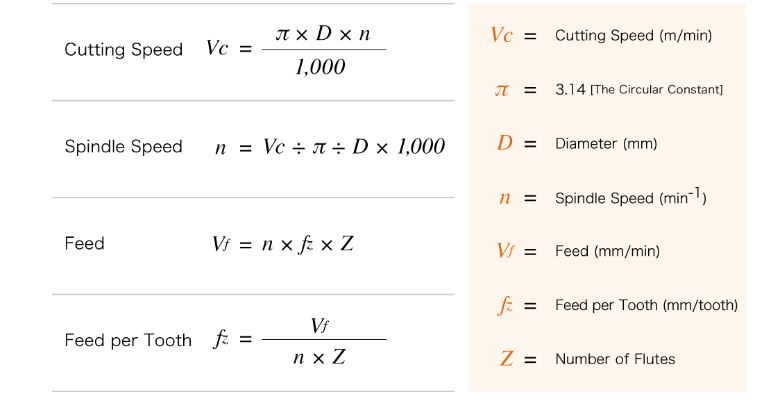
Calculating feed rate and spindle speed. Source
Determining the optimal combination of these parameters ensures smooth operation, reduces tool wear, and guarantees product precision. Usually, a combination of the material type, tool diameter, and desired finish quality helps determine these rates.
Cutter Types and Material Compatibility
The milling cutters bring versatility to machining projects, and selecting the appropriate cutter for a specific material ensures the optimum result. For example;
- A twist drill is more suitable for hole drilling.
- End mills are perfect for contouring.
- Face mills are suitable for smooth finishes
- The ball-nose cutter is preferred for 3D contour work.
Furthermore, the cutter material matters too. High-speed steel (HSS) cutters might be preferred for general jobs. But, when working with harder materials, carbide cutters offer longevity.
- Tool Path Strategies
Determining the tool path strategy is like charting a course on a map. The right path ensures efficiency, reduces machining time, and minimizes tool wear. Some common strategies include:
- Contouring: Ideal for external shapes.
- Pocketing: Used for machining internal flat areas.
- Ramping: A method to move down in z-direction.
While software (such as CAM) plays a significant role in determining these paths, understanding the basics can aid in troubleshooting and optimization.
Tolerances & Precision
CNC milling, renowned for its precision, operates within specific tolerances. Tolerance defines the permissible limit of variation in a physical dimension.
Table: Common Tolerance Ranges in CNC Milling
| Material | Tolerances (in mm) |
| Aluminum | ± 0.05 |
| Stainless Steel | ± 0.08 |
| Brass | ± 0.05 |
| Plastic | ± 0.15 |
(Note: These tolerances are achievable with the right tool and machining parameters.)
- Cooling & Lubrication
As the milling tool cuts through material, heat generation is inevitable. To counter this, coolants or lubricants are often used. These substances serve a dual purpose: cooling the tool and material and ensuring smooth movement by reducing friction. The choice between water-soluble coolants and cutting oils often depends on the material being milled and the desired finish quality.
Types of CNC Milling Operations
Various types of CNC milling operations are designed to achieve specific outcomes depending on the material type. These operations differ in the type of cutting tool used, the cut’s direction, the cut, the depth of the cut, the speed & feed rate, and other machining parameters. In addition, choosing the proper milling operation for a particular job is essential to ensure optimal efficiency, accuracy, and quality.
Let’s discuss the major CNC milling operations used in manufacturing.
- Face milling
Face milling operation involves cutting a flat surface perpendicular to the axis of rotation of the milling cutter. The face milling cutter contains teeth on the periphery and on the face of the cutter, which allows it to cut both axially and laterally.
It is used to create a flat surface on a workpiece or level its top. The typical applications of face milling include engine blocks, cylinder heads, and other flat surfaces on various workpieces.
- Peripheral milling
It is a fast and accurate machining method that offers high-quality surfaces while avoiding surface roughness. Peripheral milling involves cutting the outer edges of a workpiece using a cutting tool that rotates around the workpiece’s perimeter.
This operation is excellent for producing intricate contours or shapes on the workpiece’s exterior, such as gears, splines, and profiles.
- Slot milling
As the name suggested, Slot milling involves cutting a narrow slot or groove on the surface of a workpiece. The slot can be of varying depths and widths, depending on the design specifications. Different cutting tools, such as end mills, drill bits, and slot drills, are used in slot milling. The milling cutter rotates and engages the workpiece, removing material in a straight line to create the slot.
- Plain milling
Plain milling is a type of milling operation that creates a flat surface parallel to the axis of rotation of the milling cutter. During the operation, the milling cutter rotates and engages the workpiece, removing material in a flat plane. It can be used to create a flat surface on a workpiece, to level the top of a workpiece, or to cut a groove or slot.
- Pocket milling
Pocket milling is suitable for creating a closed pocket or cavity on the surface of a workpiece. Different cutting tools like end mills, ball nose mills, and slot drills can be used to create a pocket with various shapes, including rectangular, circular, or irregular, and can be of varying depths and widths.
- Form milling
Form milling is commonly used in manufacturing components with complex shapes because it allows cutting a workpiece into a specific condition or contour. The operation uses a tool that matches the desired contour, allowing the device to create a detailed profile or pattern on the workpiece’s surface.
- Other milling operations
Numerous other milling operations exist, such as drilling, profiling, thread milling, plunge milling, angular milling, and slide milling.
Material Selection for CNC Milling
You need to select the suitable material for a specific job to obtain the desired product’s desired quality and performance. Choosing the suitable material for milling requires several considerations milling operations, design complexity, material properties, cost, and testing.
Here’s a step-wise guide to help you make the best choice:
- Determine the end use: Determine the purpose and application of the final product will dictate the kind of material you should use based on required strength, durability, temperature resistance, and chemical resistance.
- Consider the milling operations: Different materials have varying properties that demand suitable milling tools & operations. For instance, some materials are harder to cut and may require specialized tools or milling techniques.
- Determine the required precision: Your design’s size and Complexity of your design will determine the precision and accuracy needed in your milling process. Some materials are more straightforward to mill than others, and the level of precision required may affect your material selection.
- List the material options: There are several materials to choose from, such as aluminum, brass, steel, and plastics. Make a list of possible options with the properties and characteristics of each material.
- Compare the cost: Before comparing the cost, shortlist the materials by comparing them against your requirements. Now, select the best option by considering the cost of the raw material, tooling, and labor required for milling
- Finalize your material: Once you’ve selected a material, testing and refining your milling process to ensure optimal results is essential. So, try the material with adjustments to the milling parameters and tooling. If all results are okay, finalize the material.
The Essential CNC Milling Tools
CNC milling can be categorized into various types based on the specific task at hand. Each type is crafted to deliver precise results depending on the workpiece’s needs. While milling varieties define the method or angle of interaction with the material, the tools used in the process play a pivotal role in achieving the desired finish and shape.
CNC milling tools
Choosing the right milling tool not only ensures efficiency but also guarantees the desired finish and precision in the final product. Let’s see what the common milling tools are with a table.
Table: Essential CNC Tools
| Tool | Description | Primary Use | Key Feature |
| Face Milling Tool | Multiple cutting edges for flat surfaces | Producing flat surfaces | Broad cutting surface |
| Shell Mill | Large face milling cutter with a central hole | Efficient material removal | Can be mounted to a separate arbor |
| Ball Cutter | Hemispherical cutting tip | Producing concave shapes, grooves | Rounded cutting profile |
| End Mill | Cutting edges on the end and sides | Drilling, profiling, slot cutting | Versatility in milling tasks |
Perfect Your Techniques with CNC Milling Parameters
The precision and efficiency of CNC milling don’t just rely on the machine itself but significantly on the parameters set by the operator. Fine-tuning these parameters is analogous to fine-tuning a musical instrument; the outcome is either harmonious or discordant based on the settings.
Parameter 1: Feed Rate
Determining the speed at which the cutter progresses through the material. A balanced feed rate is quintessential for multiple reasons:
- Quality of Finish: Too slow, and you risk burnishing; too fast, and you may end up with a rough finish.
- Tool Lifespan: Incorrect feed rates can wear out tools prematurely or lead to breakage.
- Efficiency: Optimizing feed rates can drastically reduce production times, enhancing efficiency.
It’s intriguing to note, as cited by a study from the International Journal of Machine Tools & Manufacture, that there’s a direct correlation between feed rates and surface roughness. Their findings indicated that a lower feed rate generally leads to a smoother surface finish.
Parameter 2: Spindle Speed( RPM)
Next on the list is the spindle speed, measured in revolutions per minute (RPM). This parameter controls how fast the milling cutter rotates, influencing several aspects:
- Heat Generation: High RPMs can generate excessive heat, potentially affecting the tool and workpiece.
- Material Removal Rate (MRR): The spindle speed plays a pivotal role in determining the MRR, which is the volume of material removed per minute.
- Tool Wear: Like the feed rate, an incorrect spindle speed can either underutilize the tool or degrade it swiftly.
The significance of spindle speed can be illustrated with insights that optimized spindle speeds could enhance tool life by up to 25%.
Parameter 3: Depth of Cut
The depth of cut, as its name suggests, refers to how deeply the tool plunges into the workpiece during milling. It’s a parameter demanding meticulous attention for several reasons:
- Strain on Tools: Deeper cuts exert more force on milling tools, demanding robust tools capable of withstanding such stresses.
- Surface Finish: A deeper cut can sometimes lead to a rougher finish, especially if other parameters aren’t optimized in tandem.
- Chatter: Excessive depths of cut can lead to vibrations or chatter, which can compromise the integrity of the workpiece and tool.
Try Prolean Now!
The Steps to Begin the CNC Milling
The complex CNC milling process becomes logical and approachable once we break down the procedures into discrete steps Let’s discuss the core steps to kick-start the CNC milling process.
Step 1: Finalize the Drawing
 Example of CAD design for Milling
Example of CAD design for Milling
Before diving into the actual milling process, it’s pivotal to have a crystal-clear blueprint or digital drawing of the desired final product. This blueprint serves as a roadmap, guiding the CNC machine.
- CAD Software: In the contemporary era, Computer-Aided Design (CAD) software has emerged as the touchstone. Such tools allow for precise digital sketches, ensuring minutiae are captured.
- Detailing: Each curve, angle, and measurement in the drawing translates to machine movements. Thus, ensuring accuracy at this stage is vital.
- Consultations: Engaging with experts or fellow designers can help refine the drawing. From my personal experience in the manufacturing industry, “Good design is thorough down to the last detail.“
During the milling preparation phase, it’s crucial to ensure dimensional accuracy in all measurements, reflecting the desired specifications. Some complex designs might necessitate adjustments for milling feasibility. Additionally, you must verify that the chosen file format is compatible with the specific CNC machine’s software.
Step 2: Choose the Material
Selecting the right material is equally significant. The choice can influence factors ranging from the tool’s lifespan to the finished product’s attributes. Materials like titanium will differ vastly in milling requirements compared to softer materials like pine wood. Here’s a succinct breakdown of common materials:
Material: TypeCommon UsesMilling Considerations
| Material Type | Common Uses | Milling Considerations |
| Aluminum | Aircraft components, Cans | Lightweight, easy to mill, can oxidize |
| Steel | Automotive parts, Tools | Robust, harder-on tools, various alloys available |
| Plastics (e.g., PVC, Acrylic) | Signage, Toys | Generally easier to mill, the potential for melting if overheated |
| Wood | Furniture, Sculptures | Varies by hardness, the potential for splintering |
Step 3: Set the Parameters
As touched upon previously, the trifecta of Feed Rate, Spindle Speed, and Depth of Cut comes into play here. But these aren’t the sole parameters to consider.
- Tool Path: This determines how the machine tool will traverse the material, and it’s derived from your CAD drawing.
- Coolant Flow: Some milling operations require coolants to dissipate heat. The flow rate and type can be crucial.
- Tool Selection: Based on material and intricacy, choosing the right milling tool – end mills, ball cutters, etc. – becomes indispensable.
Statistics can better illustrate the importance of perfect parameters” underscored that nearly 28% of CNC milling discrepancies stem from improper parameter settings.”
Step 4: Start the Milling
CNC milling machine in action
With preparations done, it’s time to bring the drawing to life.
- Machine Calibration: Before actual milling, calibrating the CNC machine is vital to ensure accuracy.
- Safety Protocols: Always adhere to safety guidelines. It includes wearing protective gear and ensuring the workspace is free of potential hazards.
- Monitoring: As the machine mills, continually monitor the process. Immediately address any deviation or discrepancies during the process.
Advantages and Disadvantages of CNC Milling Parts
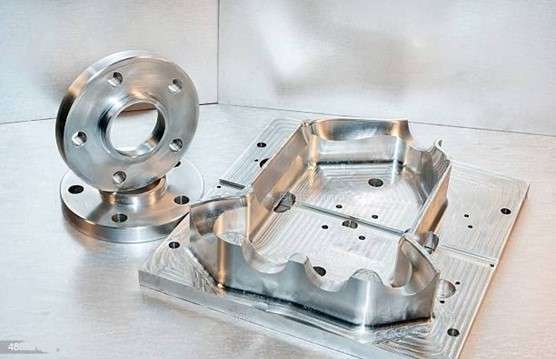
Mill parts
CNC milling is an efficient manufacturing technique with many benefits, including improved accuracy, repeatability, and efficiency compared to conventional milling. However, it has a few drawbacks, such as high installation costs and part size restrictions.
Advantages
- CNC milling machines can create exact components with tolerances as small as 0.001 inches.
- Milling operations can create identical parts with the same level of precision and accuracy, even in high-volume production runs.
- CNC milling machines can work constantly and independently, cutting down on the labor and time needed for production.
- It allows the part with complex shapes and contours
- CNC milling machines can work with a range of materials, providing greater product design flexibility. Common materials are steel, copper, titanium, aluminum, plastics, ceramics, and more.
Disadvantages
- High initial costs for equipment and training
- Limitations on Part Size and Complexity
- Lack of flexibility for small-scale production runs
- Requires skilled operators and programmers
- Maintenance and repair costs can be high
How CNC Milling Services Works?
The CNC milling services start with design creation and involve other stages throughout the process.
Here is an overview of how the CNC milling services work;
- Design Creation: The first step is to design the part to be manufactured using CAD (Computer-Aided design) software. The design can also be created from a 3D scan of an existing part.
- Conversion to CNC Code: The CAD software converts the design into a set of instructions called CNC code. This code contains the precise coordinates and movements the milling machine will use to shape the part.
- Machine Setup: The operator sets up the CNC milling machine by loading the workpiece into the machine and securing it. The operator also loads the CNC code into the machine’s computer.
- Milling Process: The milling process begins once the machine is set up. According to the CNC code, the machine uses a cutting tool, typically a rotating end mill, to remove material from the workpiece. The cutting tool moves along multiple axes, such as X, Y, and Z, to create the desired shape.
- Surface finishing: After the component has been milled, it could still need to be finished with sanding, polishing, or painting. Before being used or sent to the customer, the finished product is checked for accuracy and quality.
- Shipment and delivery: After quality inspection, manufacturers ship the parts (or products) to the clients with proper packaging
Prolean’s CNC Milling Services with Competitive Pricing
Creating precise parts with CNC milling operations could be challenging without experienced engineers and advanced mill machines. If you want to outsource the milling parts or products, Prolean can become a trusted partner. ProleanTech is a leading on-demand manufacturing company based in China with years of experience in CNC milling services for different industries.
Our CNC milling services are tailored to meet each client’s specific needs. We use advanced technology and equipment to ensure the highest standards of accuracy and precision. Additionally, our engineers work closely with clients to provide personalized solutions for unique needs and specifications.
Whether you need CNC milling services for prototyping, low-volume production runs, or high-volume production runs, Prolean has the expertise and resources to deliver top-quality results. Our competitive pricing ensures that you get the best value for your money without compromising quality or service. Please send us your design to start the project.
Summing Up
Embarking on the CNC milling journey might seem daunting initially, but with the right guidance, it becomes a rewarding endeavor. With this guide, you have a strong foundation to start your CNC journey. Always remember, every expert was once a beginner. So, practice, learn, and soon, you’ll master the art of CNC milling. Considering Professional Services? For those looking for expert assistance or high-quality milling services, Prolean’s Metal CNC Milling services come highly recommended. Backed by years of experience and state-of-the-art equipment, we ensure precision and quality in every project. Please don’t hesitate to contact us.
FAQ
What is CNC milling?
It is a machining process that uses computer-controlled rotating cutting tools to remove material from a workpiece. The cutting tool moves in multiple axes to create complex shapes and features, where the computer program dictates the tool’s movement.
What are the different types of CNC milling operations used in manufacturing?
Some common types of CNC milling operations used in manufacturing include face milling, end milling, drilling, and tapping.
What factors should be considered when choosing a milling operation for a specific job?
Different factors should be considered, including the material being machined, the required tolerances, the desired surface finish, and the available cutting tools and equipment,

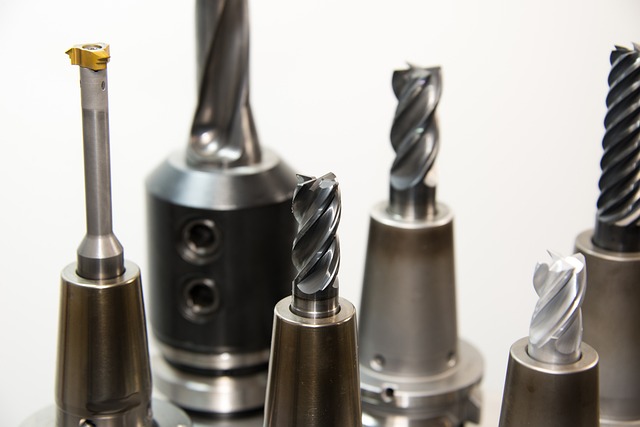
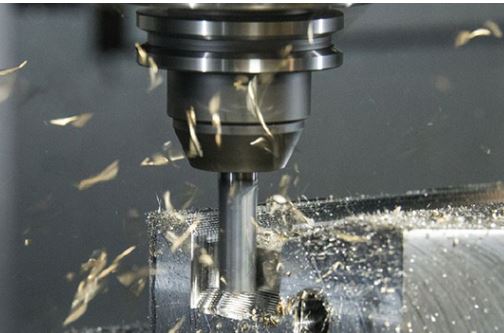



I am trying to kickstart my career as a CNC operator in American Manufacturing industry. And this article not only give the concise knowledge but also motivates me for my goal.
Thanks Ethan, for your words! Best of for your future and if you need any assistance please let-us know!
This is the article i am looking for. Great composure.